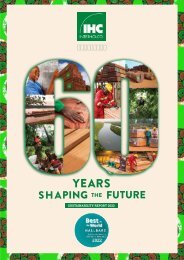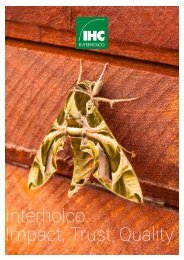Nomenclature Générale des Bois Tropicaux - 7ème édition
(english description below) Cette nomenclature est utilisée pour la mise à jour du 'Harmonized Code System' de l’Organisation Mondiale des Douanes. Dans la circulaire du 5 avril 2005, le Ministère de l’Economie, des Finances et de l’Industrie (France) reconnaît l’ATIBT comme « gardien du temple » de la nomenclature des bois tropicaux. La Commission Européenne mentionne la nomenclature de l’ATIBT comme document de référence pour la mise en œuvre du RBUE. Depuis 1954, l’ATIBT a établi et mis à jour une nomenclature des bois tropicaux faisant correspondre chaque espèce botanique avec un nom pilote reconnu internationalement. La détermination du nom pilote d’une essence est cruciale, car sa commercialisation dépend très largement de l’adoption de ce nom par le public. Le nom pilote assure la protection de l’appellation commerciale de l’essence et l’intégrité des propriétés qui lui sont attribuées, sans risque de confusion. The 1982 version of the general timber nomenclature has finally been updated as some of the 1,750 identified species, are no longer traded, while others, which were not previously included, are now on the market. The present revision has also integrated changes related to new taxonomy, in order to reflect the latest scientific developments. This Nomenclature has been used for the Harmonized Code System, updated by the World Customs Organization. The French Ministry of economy, finance and industry has given official recognition to ATIBT as the reference for the tropical timber nomenclature (NOR: PRMX0508285C of April 5th 2005). The European Commission refers to ATIBT nomenclature as a reference document for the implementation of the EUTR regulation. Since 1954, ATIBT has established and updated a nomenclature of tropical wood, linking each botanical species with an internationally recognized pilot name. A sigle wood species may have many common names; when trading across different countries, this may lead to confusion. Fixing the pilot name of a timber species is crucial, to protect the commercial denomination of the species and guarantee the veracity of the properties linked to that species, without confusion.
(english description below)
Cette nomenclature est utilisée pour la mise à jour du 'Harmonized Code System' de l’Organisation Mondiale des Douanes. Dans la circulaire du 5 avril 2005, le Ministère de l’Economie, des Finances et de l’Industrie (France) reconnaît l’ATIBT comme « gardien du temple » de la nomenclature des bois tropicaux. La Commission Européenne mentionne la nomenclature de l’ATIBT comme document de référence pour la mise en œuvre du RBUE.
Depuis 1954, l’ATIBT a établi et mis à jour une nomenclature des bois tropicaux faisant correspondre chaque espèce botanique avec un nom pilote reconnu internationalement. La détermination du nom pilote d’une essence est cruciale, car sa commercialisation dépend très largement de l’adoption de ce nom par le public. Le nom pilote assure la protection de l’appellation commerciale de l’essence et l’intégrité des propriétés qui lui sont attribuées, sans risque de confusion.
The 1982 version of the general timber nomenclature has finally been updated as some of the 1,750 identified species, are no longer traded, while others, which were not previously included, are now on the market. The present revision has also integrated changes related to new taxonomy, in order to reflect the latest scientific developments.
This Nomenclature has been used for the Harmonized Code System, updated by the World Customs Organization. The French Ministry of economy, finance and industry has given official recognition to ATIBT as the reference for the tropical timber nomenclature (NOR: PRMX0508285C of April 5th 2005). The European Commission refers to ATIBT nomenclature as a reference document for the implementation of the EUTR regulation.
Since 1954, ATIBT has established and updated a nomenclature of tropical wood, linking each botanical species with an internationally recognized pilot name. A sigle wood species may have many common names; when trading across different countries, this may lead to confusion. Fixing the pilot name of a timber species is crucial, to protect the commercial denomination of the species and guarantee the veracity of the properties linked to that species, without confusion.
You also want an ePaper? Increase the reach of your titles
YUMPU automatically turns print PDFs into web optimized ePapers that Google loves.
Liste des noms scientifiques des bois tropicaux avec renvoi au nom pilote /// 17
NOM BOTANIQUE
BOTANICAL NAME
FAMILLE
FAMILY
CONTI-
NENT
NOM PILOTE
PILOT NAME
Castanopsis sclerophylla Schottky Fagaceae AS Chinquapin
Castanospermum australe A. Cunn. Leguminosae (Fabaceae) AS Blackbean
Casuarina spp. Casuarinaceae AS Beefwood
Casuarina cunninghamiana Miq. Casuarinaceae AS Beefwood
Casuarina equisetifolia L. Casuarinaceae AS Beefwood
Casuarina junghuhniana Miq. Casuarinaceae AS Beefwood
Catostemma spp. Malvaceae (Bombacaceae) AM Baromalli
Catostemma commune Sandw. Malvaceae (Bombacaceae) AM Baromalli
Catostemma fragans Benth. Malvaceae (Bombacaceae) AM Baromalli
Catostemma sclerophyllum Ducke Malvaceae (Bombacaceae) AM Baromalli
Cavanillesia platanifolia H.B.K. Malvaceae (Bombacaceae) AM Quipo
Cecropia spp. Urticaceae (Cecropiaceae) AM Imbauba
Cecropia obtusa Trécul Urticaceae (Cecropiaceae) AM Imbauba
Cecropia palmata Willd. Urticaceae (Cecropiaceae) AM Imbauba
Cecropia peltata L. Urticaceae (Cecropiaceae) AM Imbauba
Cedrela angustifolia C. DC. Meliaceae AM Cedro
Cedrela fissilis Vell. * Meliaceae AM Cedro
Cedrela mexicana M. Roem. (cf. C.odorata) Meliaceae AM Cedro
Cedrela odorata L. Meliaceae AM Cedro
Cedrela toona Roxb. (cf. Toona cialata) Meliaceae AS Suren
Cedrelinga cateniformis Ducke Leguminosae (Mimosaceae) AM Tornillo
Cedrelopsis spp. Meliaceae AF Katrafay
Cedrelopsis grevei Baill. & Courchet Meliaceae AF Katrafay
Ceiba pentandra Gaertn. Malvaceae (Bombacaceae) AF Fuma
Ceiba pentandra Gaertn. Malvaceae (Bombacaceae) AM Sumauma
Ceiba samauma K. Schum. Malvaceae (Bombacaceae) AM Sumauma
Ceiba thonningii A. Chev. (cf. C.pentandra) Malvaceae (Bombacaceae) AF Fuma
Celtis spp. (AS) Cannabaceae (Ulmaceae) AS Hard Celtis
Celtis p.p. (AF) Cannabaceae (Ulmaceae) AF Diania
Celtis p.p. (AF) Cannabaceae (Ulmaceae) AF Ohia
Celtis adolfi-friderici Rendle Cannabaceae (Ulmaceae) AF Diania
Celtis brieyi De Wild. (cf. C.tessmanii) Cannabaceae (Ulmaceae) AF Diania
Celtis gomphophylla Baker Cannabaceae (Ulmaceae) AF Ohia
Celtis latifolia Planch. Cannabaceae (Ulmaceae) AS Hard Celtis
Celtis mildbraedii Engl. Cannabaceae (Ulmaceae) AF Ohia
Celtis paniculata Planch. Cannabaceae (Ulmaceae) AS Hard Celtis
Celtis philippensis Blco. Cannabaceae (Ulmaceae) AS Hard Celtis
Celtis soyauxii Engl. (cf. C.zenkeri) Cannabaceae (Ulmaceae) AF Ohia
Celtis tessmannii Engl. Cannabaceae (Ulmaceae) AF Diania
Celtis zenkeri Engl. Cannabaceae (Ulmaceae) AF Ohia
Centrolobium spp. Leguminosae (Fabaceae) AM Araribà














